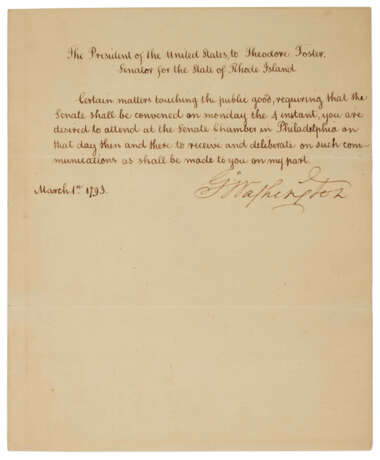ID 887944
Lot 166 | Summoning a senator to attend his second inauguration
Estimate value
$ 25 000 – 35 000
One page, 236 x 195mm bifolium (small edge tears reinforced on verso).
Washington calls Congress into session for his second inauguration. The routine language of Washington's summons belies its significance: terms for representatives and retiring members of the Senate in the Fourth Congress expired on 3 March 1797. The following day would mark not only the commencement of a new congress, but the start of Washington's second presidential administration: "Certain matters touching the public good, requiring that the Senate shall be convened on monday the 4 instant, you are desired to attend at the Senate Chamber in Philadelphia on that day, then and there to receive and deliberate on such communications as shall be made to you on my part." According to contemporary accounts, the ceremony was a simple affair. On Monday 4 March, the members of both houses of Congress, the cabinet, the Supreme Court were joined an assemblage that also included foreign diplomats, and "a number of private citizens, ladies and gentleman," in the Senate Chamber within Congress Hall–located on the corner of 6th Street and Chestnut in Philadelphia. "At twelve o'clock precisely, the President of the United States entered the hall. Mar. Langdon, President pro tempore, then rose and said: Sir, one of the Judges of the Supreme Court of the United States is now present, and ready to administer to you the oath required by the constitution, to be taken by the President of the United States." With that, Washington delivered a "short, but comprehensive speech," and then Justice William Cushing administered the oath of office. "After taking the oath, the President retired, as he had come, without pomp or ceremony: on his departure from the house, the People saluted him with three cheers." (National Gazette, 6 March 1793, p. 4).
Rare. One of five surviving editions of this important circular letter. The Papers of George Washington note four other extant examples the circular addressed to Robert Morris of Pennsylvania, Roger Sherman of Connecticut, Theodore Foster of Rhode Island, and John Rutherford of New Jersey. (See Papers, Pres. Ser., 12:243 fn1).
| Artist: | George Washington (1732 - 1799) |
|---|---|
| Place of origin: | USA |
| Auction house category: | Letters, documents and manuscripts |
| Artist: | George Washington (1732 - 1799) |
|---|---|
| Place of origin: | USA |
| Auction house category: | Letters, documents and manuscripts |
| Address of auction |
CHRISTIE'S 8 King Street, St. James's SW1Y 6QT London United Kingdom | |
|---|---|---|
| Preview |
| |
| Phone | +44 (0)20 7839 9060 | |
| Buyer Premium | see on Website | |
| Conditions of purchase | Conditions of purchase |











